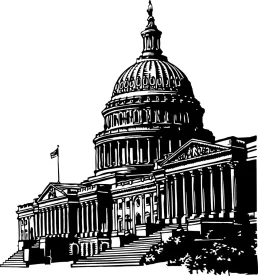On March 18, 2020, shortly after it was passed in the Senate by a vote of 90-8, President Trump signed H.R. 6201, the Families First Coronavirus Act (the “Act”) into law.
There are two paid leave provisions of the Act that employers with fewer than 500 employees should be aware of: (1) the Emergency Family and Medical Leave Expansion Act; and (2) the Emergency Paid Sick Leave Act. The Act also provides, among other things, $1 billion in grants to states for emergency unemployment insurance and refundable tax credits for employers providing paid emergency sick leave or paid FMLA. Further, for those who have been closely following the trajectory of this bill, it is worth noting that there are key differences as highlighted below between the original version of the bill passed by the House on March 14 and the final law, which are the result of several “corrections” that the House made to the bill on March 16 before sending it to the Senate.
- Paid Job-Protected Leave Under the Family and Medical Leave Act
Like the original bill passed by the House on March 14, the law provides employees of employers with fewer than 500 employees with the right to take up to 12 weeks of job-protected leave under the Family and Medical Leave Act (“FMLA”) for certain reasons related to the COVID-19 pandemic. Unlike the original March 14 bill, however, the reasons for which an employee can take this paid FMLA leave have been significantly curtailed. Further, the amount of pay an employee is entitled to receive while taking this FMLA leave has also been reduced.
Here are the key points that employers need to know:
- Who Is Eligible for the FMLA Leave? An employee who has been employed for at least 30 days and is unable to work (or telework) due to a need to care for minor children if: (1) a school or place of care has been closed; or (2) the child care provider of such children is unavailable due to a public health emergency (defined as an emergency with respect to COVID-19 declared by a federal, state, or local governmental authority).
- What Are Eligible Employees Entitled To? An employee is entitled to 10 days of unpaid leave (the employee may choose to substitute accrued paid time off or other medical or sick leave during this period) and 10 weeks of paid leave at a rate of two-thirds of the employee’s regular rate of pay, at the number of hours that the employee is regularly scheduled to work. Paid leave, however, cannot exceed $200 a day or $10,000 in total.
- Is the Job Leave Protected? As with traditional FMLA leave, this leave is job-protected and an employer must return the employee to the same or equivalent position upon their return to work. The bill outlines an exception for employers with less than 25 employees if the employee’s job no longer exists due to the coronavirus pandemic, which requires employers to make reasonable efforts to restore the employee to an equivalent position.
- Are There Any Types of Employers Excluded From the Act? The bill grants the Secretary of Labor the authority to issue regulations exempting: (1) certain health care providers and emergency responders from taking leave under the bill; and (2) small business with fewer than 50 employees from the requirements of the bill if it would jeopardize the viability of the business. The Act also gives employers of health care providers and emergency responders the ability to opt out of providing the FMLA leave required by the Act. Further, under certain circumstances, an employer party to a multiemployer collective bargaining agreement can satisfy its obligations to provide paid sick time by making an equivalent contribution to the multiemployer plan fund.
- What Are the Notice Provisions? When the need for leave is foreseeable, employees only need to notify employers of the need for leave when it is practicable. The Act is silent regarding notice requirements for unforeseeable leave.
- Are the Civil Penalties the Same as Under the FMLA? They appear to be with one exception: employers who do not meet the standard definition of employer under the FMLA (employers with less than 50 employees) are excluded from civil liability for violations of this amendment.
There are several issues that the Act does not address—the most notable of which is how an employer determines whether it has fewer than 500 employees (e.g., are employees of parents and subsidiaries included in the calculation? Do part-time and temporary employees count as full-time employees? What time frame should be used when making the calculation?). At this point, we anticipate that courts and the Department of Labor will rely on standards used for determining employer size under the FMLA (which would mean a joint employer analysis).
Please note that this amendment to the FMLA will take effect no later than April 2, 2020 (15 days after presidential approval) and expire on December 31, 2020.
- Emergency Paid Sick Leave
The Act also provides employees of employers with fewer than 500 employees with up to 2 weeks (80 hours) of paid sick leave.
Notable aspects of the Act include the following:
- Who Is Eligible for the Paid Sick Leave? Employees, regardless of length of employment, are entitled to paid sick leave if they are unable to work (or telework) for the following reasons:
- The employee is subject to a Federal, State, or local quarantine or isolation order related to COVID-19;
- The employee has been advised by a health care provider to self-quarantine due to concerns related to COVID-19;
- The employee is experiencing symptoms of COVID-19 and seeking a medical diagnosis;
- The employee is caring for an individual who is subject to an order to quarantine or self-isolate or has been advised by a health care provider to self-quarantine due to concerns related to COVID-19;
- The employee is caring for a son or daughter of such employee if the school or place of care of the son or daughter has been closed, or the child care provider of such son or daughter is unavailable, due to COVID-19 precautions; or
- The employee is experiencing any other substantially similar condition specified by the Secretary of Health and Human Services in consultation with the Secretary of the Treasury and the Secretary of Labor.
- How Much Leave Are Eligible Employees Entitled To? Full time employees are eligible for up to 2 weeks (80 hours) of paid sick leave. Part-time employees are entitled to the number of hours of paid sick time equal to the number of hours they work, on average, over a 2-week period.
- How Much Are Employees Required to Be Compensated When Taking Paid Sick Leave Under the Act? Unlike the original March 14 bill, the law states that paid sick time shall not exceed: (1) $511/day and $5,110 in the aggregate for employees utilizing the leave for reasons (1) – (3) listed above; and (2) $200/day and $2,000 in the aggregate for employees utilizing the leave for reasons (4) – (6) listed above. For reasons (1) – (3), the pay must be provided at an employee’s regular rate of pay (which must equal or exceed minimum wage); for reasons (4) – (6), the rate of pay must be no less than two-thirds of the employee’s regular rate of pay or the minimum wage (whichever is greater). The Secretary of Labor is required to issue regulations regarding how paid leave should be calculated under the Act. (The Secretary also has the authority to issue regulations excluding health care providers and emergency responders from compliance with the Act, exempting business with less than 50 employees if compliance would jeopardize the viability of the business, and as necessary to carry out the Act.)
- What Are the Notice Requirements? After the first workday (or a portion thereof) on which leave is utilized, the employer can require the employee to comply with “reasonable notice procedures” to continue receiving paid sick leave under the Act.
- Can an Employer Require an Employee to Utilize Other Paid Leave Before Accessing Emergency Paid Leave?
- What About Health Care Providers and Emergency Responders? Employers of health care providers or emergency responders may exclude employees from entitlement to this leave.
- Do Employers Need to Pay out Unused Leave Under the Act Upon Separation of Employment?
- What Are the Penalties for Failure to Comply? The penalties are the same as those under the Fair Labor Standards Act for failure to pay the federal minimum wage.
The Act also has: (1) a notice-posting requirement (the Secretary of Labor must make a model notice publicly available by March 25); (2) a provision prohibiting discrimination and retaliation against employees who utilize this leave; and (3) an exception for certain employers signatory to a multiemployer collective bargianing agreement.
This provision of the Act will take effect no later than April 2, 2020 (15 days after presidential approval) and expires on December 31, 2020 (unused leave cannot carry over to 2021).
We will continue to provide updates after the Secretary of Labor issues regulations.




 />i
/>i

